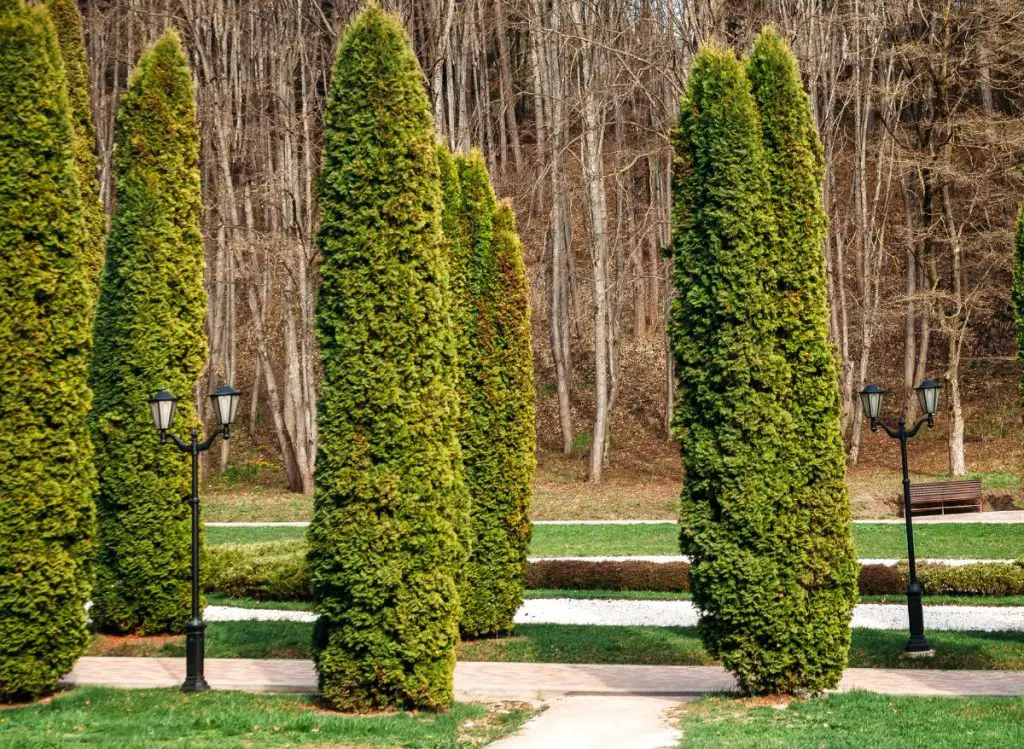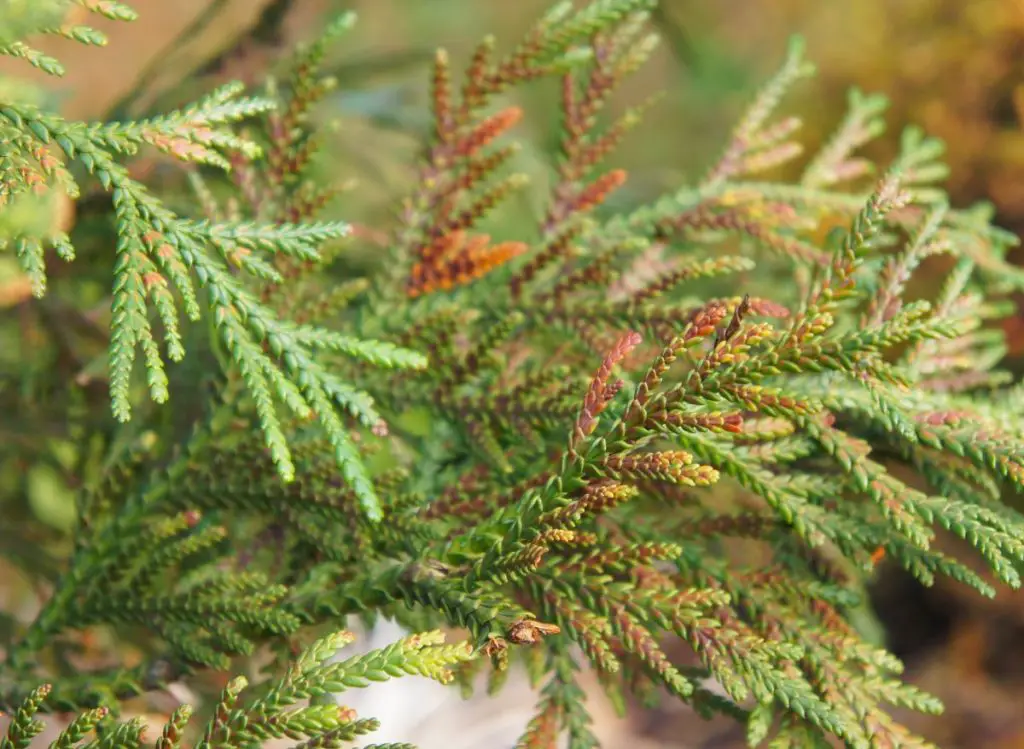This post contains affiliate links.

Arborvitae (Thuja occidentalis) is a popular evergreen tree in landscaping, popularly known for its pyramid shape and dense foliage. This tree is a great addition to any landscape because it can provide much-needed shade, privacy, and beauty.
However, just like any other plant, arborvitae is not immune to diseases and pests that can cause significant damage and even death. Arborvitae disease is a common problem that gardeners and landscapers face, but the good news is that it is treatable.
If you want to protect and treat your arborvitaes from disease, read on to explore how to treat arborvitae disease effectively to help you maintain healthy and thriving trees all year long. Check out this article if you wonder how to deal with too much Iron in your garden’s soil.
Arborvitae Overview
Arborvitae disease is a common problem that can significantly affect the health and beauty of your tree. Prevention is always better than cure, but if the disease strikes, there are several treatment options you can choose from.
Before discussing how to effectively treat Arborvitae disease, let’s explore the key characteristics of an Arborvitae plant.
The table below contains Arborvitae’s keys characteristics
| Genus name | Thuja occidentalis |
| Common name | – American Arborvitae – Eastern White Cedar – Northern White Cedar – Eastern Arborvitae |
| Plant type | – Tree – Native Plant |
| Mature size | – Height: 40 to 60 feet (12.2 to 18.29 meters) – Width: 10 to 15 feet (3.05 to 4.6 meters) |
| Species | Occidentalis |
| Family | Cupressaceae |
| Life Cycle | Woody |
| Soil Drainage | – Good Drainage – Occasionally Dry – Moist |
| Sun exposure | – Arborvitae trees require full sun and at least 6 hours of direct sunlight daily. – Arborvitae trees also do well in partial shade, with between 2 to 6 hours of direct sunlight only part of the day. |
| Best soil texture for olive trees | Clay Loamy (Silt) soils |
| Growth Rate | Slow |
| Leaf Color | – Green – Gold – Yellow – Gray – Silver |
| Arborvitae Benefits | – Fragrance – Wildlife Nesting – Screening – Wind Break – Wildlife Cover/Habitat |
| Resistance to challenges | – Wet Soil – Pollution – Black Walnut |
| Maintenance requirements | Low |
| Soil pH | Between 6.0 to 8.0 (Source: North Dakota State University) |
| Temperature requirements | Between 60 to 90°F (15 to 32°C). |
| Diseases and pests | – It is susceptible to damage, including stem breakage from ice and snow accumulations in winter. – Deer browsing can cause damage. – Bagworms, mealybugs, scales, and spider mites – Canker can occasionally be a problem. |
| Attracts | – Songbirds – Small Mammals |
| USDA Plant Hardiness Zone | 3 to 7 |
| Region Of Origin | Central And Eastern Canada to Northern Central and Eastern North America |
9 Expert Tips To Effectively Treat Arborvitae Disease
According to the University of Massachusetts, Amherst, the best way to treat Arborvitae disease is to prune and toss as many infected plant parts as much as possible.
Here are 9 best expert tips to effectively and successfully treat Arborvitae disease:
1- Identify the Signs of Arborvitae Disease
The first step in treating Arborvitae disease is recognizing the symptoms. The most common type of needle blight fungal disease found on arborvitae is pestalotiopsis, and it attacks foliage that has been injured or weakened by adverse weather or growing conditions, according to experts from Missouri Botanical Garden.
Arborvitae trees are susceptible to a variety of diseases, including fungal and bacterial infections.
- Look for foliage that appears brown, orange, yellow, or bronze in color in the middle or bottom of the tree, dying branches, or thinning foliage all around.
- Insects like spider mites and bagworms can also cause damage to Arborvitae trees.
- Common arborvitae diseases include root rot, canker, and Cedar Apple Rust. These diseases manifest in different ways, including yellow or brown leaves, browning of the stem, or a white or black powdery substance on the foliage.
By recognizing the symptoms of Arborvitae disease, you can take the proper steps to prevent the disease from spreading and restore your tree’s health.
2- Preventive Measures
Taking steps to prevent arborvitae disease is always better than trying to treat it. Some of the preventive measures include proper pruning to promote air circulation, maintaining proper soil moisture and pH levels, avoiding planting too close, and regularly inspecting your tree for signs of disease or pests.
Reduce the stress on your Arborvitae trees as much as possible; according to Iowa State University experts, one of the best ways to improve growing conditions is by watering when needed and mulching the trees to make them less exposed to diseases.
Also, experts from Pacific Northwest Extension Publication recommend protecting Arborvitae plants from extreme weather conditions, including winter cold or summer sunburn.
3- Address the Root Cause
Arborvitae disease can be brought on by various factors ranging from insect infestations to poor care practices. It is essential to address the root of the problem instead of merely treating the symptoms.
For instance:
- If pest infestations are causing tree damage, you may want to invest in insecticides or pest control services.
- If the disease is due to over-watering, exposure to harsh weather, or poor soil quality, adjusting your care practices can prevent further damage.
4- Treatment Options for Arborvitae Disease
If you have noticed any symptoms of arborvitae disease in your tree, do not panic. There are several treatment options to choose from, depending on the severity of the disease.
The first step is to prune any infected parts to prevent the disease from spreading. You can then use fungicides, including copper-based or sulfur-based products, to deal with fungal infections.
For bacterial infections, you may need to resort to antibiotics. It is important to follow the manufacturer’s recommended application rates and frequency.
5- Natural Remedies
If you are looking for natural remedies to treat arborvitae disease, there are several options available. One of the most effective is baking soda mixed with water and sprayed on the foliage, which helps to prevent fungal infections.
Applying compost tea directly to the soil around the tree can help promote soil health and increase its resistance to diseases.
You can also use neem oil, which is an organic insecticide that controls various pests that attack arborvitae trees.

6- Prune Diseased Parts
Once you’ve identified diseased branches or foliage, you should promptly remove them to prevent further spreading of the disease.
You can do this manually if the diseased area is limited. If the tree has significant damage, I recommend hiring a professional arborist to evaluate the damage and prune the tree accordingly.
7- Apply Fungicide to Control Disease
It is generally recommended to avoid applying fungicides unless it is necessary. Always read and follow product label directions before application to plants.
However, in some cases, applying a suitable fungicide is a great way to control Arborvitae disease and prevent its spread.
A basic copper fungicide is often sufficient to eliminate common plant diseases if they are caught early. For more severe cases, you may need to use a systemic fungicide.
8- Maintain Proper Care Practices
Maintaining proper care practices is essential to prevent Arborvitae disease. Avoid over-watering the tree and make sure it’s not exposed to harsh environmental conditions such as extreme heat or cold.
Regular pruning, fertilizing when needed, and avoiding harsh chemical treatments can go a long way in keeping your arborvitae trees healthy.
Here are a few experts tips on properly caring for Arborvitae:
- Avoid overcrowding plants to allow for adequate sunlight and air circulation.
- Keep Arborvitae trees healthy with good cultural practices. I encourage you always to follow proper watering and fertilization practices and minimize snow or ice damage to prevent an entry point for any fungus.
- Prune out dead twigs and foliage as soon as possible.

9- Seeking Professional Help
If the arborvitae disease has persisted despite your best efforts, it is time to seek professional help. A professional arborist can assess the extent of the disease and recommend the best course of action.
More importantly, professionals have the skills and experience to deal with arborvitae diseases, and you can rest assured that your tree is in good hands.
What to read next:
- The Experts’ Guide on the Best Crabgrass Killer that Won’t Kill Grass.
- Say Goodbye to Crabgrass: Effective and affordable homemade Crabgrass killer!
- A Quick And Helpful On How To Speed Up Grass Seed Germination.
Wrapping Up
If your trees are already suffering from Arborvitae disease, it is essential to address the problem immediately by properly identifying the symptoms, pruning diseased parts, applying fungicides, and adapting proper care practices.
Regardless of the treatment option you choose, it is important to stay vigilant and regularly inspect your tree to stay ahead of any problems. By following the steps outlined in this article, you can maintain the health and beauty of your arborvitae for years to come.

